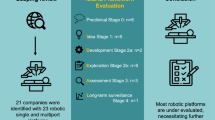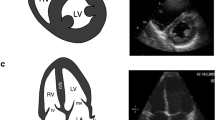Abstract
Purpose
Metallic foreign bodies (MFBs) retained in soft tissue may pose potential threats to patient health. Interventional procedures using conventional navigation systems are associated with high rate of radiation exposure. We postulated that the surgical approach visualization and navigation system would offer precise percutaneous localization and linear guidance with reduced radiation dosage and system complexity.
Methods
In total, 76 patients underwent percutaneous MFB extraction with the technique, which consists of: (A) displaying the target spot (here the MFB) on the screen; (B) projecting the laser beam onto the skin surface; (C) indicating the optimal direction and angle of the needle; and (D) guiding the surgical approach until the MFB was extracted.
Results
A total of 76 MFBs were successfully extracted with a single operation. No systemic complications were observed. The procedure took between 2 and 11 min, with an average of \(5.55\pm 2.21\) min, demonstrating the characteristics of a normal distribution. The mean size of wound was \(12.01\pm 4.16\) mm. The mean amount of bleeding was \(6.12\pm 3.56\) ml. The number of times the intra-operative fluoroscopy was used ranged from one to four times for a single procedure, with an average of 1.89 ± 0.74.
Conclusion
The proposed navigation system which combines the laser positioning and navigation techniques seems to be a novel surgical approach of high accuracy and efficiency.



Similar content being viewed by others
References
Xing GF, Shi CW, Qian HX, Qin XJ (2013) Novel methods of removing metallic foreign body from human soft tissue: a report of 7390 cases. J Surg Res 183:337–340
Gutiérrz V, Radice F (2003) Late bullet migration into the knee joint. Arthroscopy 19:1–3
Decker P, Höfler HR, Decker D, Schnarkowski P, Hansis M (1994) Traumatic foreign body embolism from the basilic vein. Unfallchirurg 97:372–374
Teltzrow T, Hallermann C, Muller S, Schwipper V (2006) Foreign body-induced angiosarcoma 60 years after a shell splinter injury. Mund Kiefer Gesichtschir 10:415–418
Iskandar ME, Eiref SD, Leitman IM (2013) The Iliad and the Odyssey of metallic foreign body extraction: commentary on “ Novel methods of removing metallic foreign body from human soft tissue: a report of 7390 cases”. J Surg Res 185:e31–e33
Callegari L, Leonardi A, Bini A, Sabato C, Nicotera P, Spano’ E, Mariani D, Genovese EA, Fugazzola C (2009) Ultrasound-guided removal of foreign bodies: personal experience. Eur Radiol 19:1273–1279
Marmurek J, Wedlake C, Pardasani U, Eagleson R, Peters T (2006) Image-guided laser projection for port placement in minimally invasive surgery. Stud Health Technol Inform 119:367–372
Wei R, Liu XZ, Guo B, Shu DL, Tan ZM (2010) Removal of a foreign body from the skull base using a customized computer-designed guide bar. J Craniomaxillofac Surg 38:279–283
Cevidanes LH, Tucker S, Styner M, Kim H, Chapuis J, Reyes M, Proffit W, Turvey T, Jaskolka M (2010) Three-dimensional surgical simulation. Am J Orthod Dentofac Orthop 138:361–371
Park SS, Yang HJ, Lee UL, Kwon MS, Kim MJ, Lee JH, Hwang SJ (2012) The clinical application of the dental mini C-arm for the removal of broken instruments in soft and hard tissue in the oral and maxillofacial area. J Craniomaxillofac Surg 40:572–578
Doke T, Liang JT, Onogi S, Nakajima Y (2015) Fluoroscopy-based laser guidance system for linear surgical tool insertion depth control. Int J Comput Assist Radiol Surg 10:275–283
Proschek D, Kafchitsas K, Rauschmann MA, Kurth AA, Vogl TJ, Geiger F (2009) Reduction of radiation dose during facet joint injection using the new image guidance system SabreSourceTM: a prospective study in 60 patients. Eur Spine J 18:546–553
Mahesh M (2001) Fluoroscopy: patient radiation exposure issues. Radiographics 21:1033–1045
Berrington de González A, Darby S (2004) Risk of cancer from diagnostic X-rays: estimates for the UK and 14 other countries. Lancet 363:345–351
Charles M (2001) UNSEAR report 2000: sources and effects of ionization radiation. J Radiol Prot 21:83–86
Tuohy CJ, Weikert DR, Watson JT, Lee DH (2011) Hand and body radiation exposure with the use of mini C-arm fluoroscopy. J Hand Surg Am 36:632–638
Ewers R, Schicho K, Undt G, Wanschitz F, Truppe M, Seemann R, Wagner A (2005) Basic research and 12 years of clinical experience in computer-assisted navigation technology: a review. Int J Oral Maxillofac Surg 34:1–8
Volonte F, Pugin F, Bucher P, Sugimoto M, Ratib O, Morel P (2011) Augmented reality and image overlary navigation with OsiriX in laparoscopic and robotic surgery: not only a matter of fashion. J Hepatobiliary Pancreat Sci 18:506–509
Sugano N, Sasama T, Nishihara S, Nakase S, Nishii T, Miki H, Momoi Y, Yoshinobu S, Nakajima Y, Tamura S, Yonenobu K, Ochi T (2002) Clinical applications of a laser guidance system with dual laser beam rays as augmented reality of surgical navigation. Congress and exhibition on computer assisted radiology and surgery. Springer, Berlin, pp 281–284
Glossop ND, Wang ZH (2003) Laser projection augmented reality system for computer-assisted surgery. CARS 1256:65–71
Acknowledgments
The study was funded by the Zhejiang Natural Science Foundation (Y2101270) and by HangZhou Santa Medical Technology Co., Ltd.
Author information
Authors and Affiliations
Corresponding author
Ethics declarations
Conflict of interest
None.
Ethical approval
The study was approved by the Ethics Committee.
Informed consent
Informed consent was obtained from all participating patients.
Rights and permissions
About this article
Cite this article
He, B., Xu, C., Mao, Y. et al. A novel navigation system to guide metallic foreign body extraction. Int J CARS 11, 2105–2110 (2016). https://doi.org/10.1007/s11548-016-1424-1
Received:
Accepted:
Published:
Issue Date:
DOI: https://doi.org/10.1007/s11548-016-1424-1




